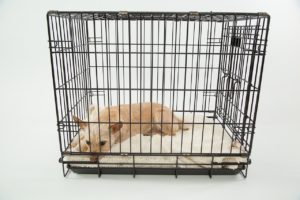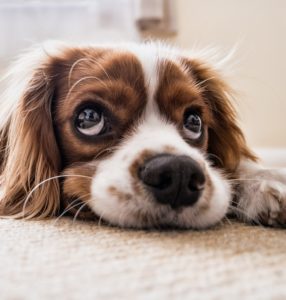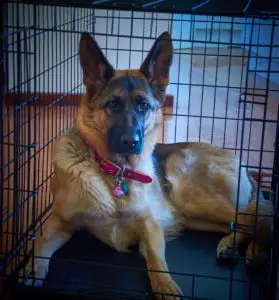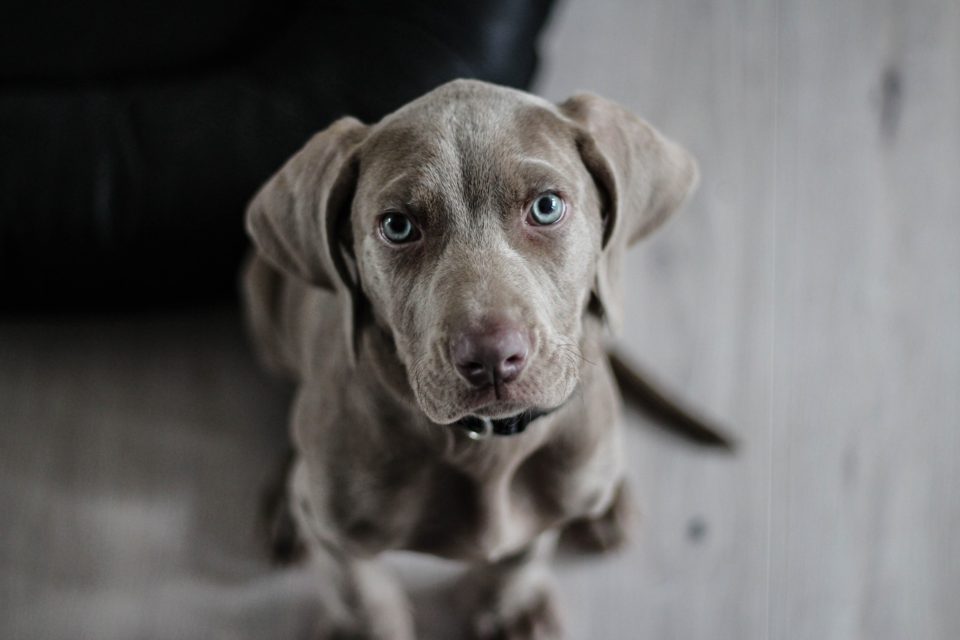Hi, my name’s Tiara and I’m a dog trainer who’s trained 100’s of dogs!
One aspect of dog training that is vital is learning how to leave your puppy alone for the first time.
It is essential you teach your puppy how to be alone. Yes, I said teach. From conception puppies are never alone (with the exception of litters of one).
They are born together and grow together. Therefore, it’s unreasonable- and potentially traumatic- to throw your puppy in a crate, leave them alone, and expect them to be ok.
Conventional crate training instructs new puppy parents to do just that- create a schedule, ignore a whining puppy, and no matter what, do not let the puppy out.
Like any method, that can work, it can also cause trauma if done incorrectly or done heavy handed with a sensitive puppy.
More and more we are seeing cases of separation anxiety, a behavioral condition where dogs become severely anxious, and even destructive, when left alone.
Dogs with severe separation anxiety have been known to chew through crates, walls, and even damage doors trying to get to their owners.
Don’t despair, this article is not intended to scare you. My goal is to educate new puppy parents and teach you how to ease your puppy into alone time. Dogs are intelligent creatures and they can learn to be alone.
It All Starts With The Crate
 There are many ways to raise a dog, but the consensus among trainers, veterinarians, and behaviorists is crate training is the best method for training a young puppy.
There are many ways to raise a dog, but the consensus among trainers, veterinarians, and behaviorists is crate training is the best method for training a young puppy.
I will note that it’s called crate training and training the dog to the crate is the first step.
It is possible to housetrain a dog without using a crate. It’s done often, but I do not recommend it. Especially for working pet parents.
If you’re looking for a dog crate, why not check out our article on the best dog crates here!
House Training
When most pet owners hear or see the term “house training” they think “potty training”.
For me, a trainer of over 20 years, I have distinguished these terms with my students as two seperate training opportunities:
Potty training: Teaching your puppy the appropriate place to go potty.
House training: Teaching your puppy how to behave in the house.
The crate is a highly effective tool in potty training as dogs are, generally, naturally clean and do not want to lay in their waste. Mama dogs keep the babies meticulously clean. When puppies start moving around on their own they tend to “go” where ever they are.
If your puppy is only exposed to the crate (where she is naturally inclined to keep clean) and the potty spot, accidents will be greatly reduced. Couple that with positive reinforcement when the puppy goes in the correct place and it doesn’t usually take long for the puppy to learn what you want.
Aside from potty training, the crate is very useful in teaching your puppy the rules of the house- what’s appropriate to chew, where they can go, where the toys are- as well as these reasons:
- Provides a safe space away from harmful household items
- Prevents potential injury when you can’t supervise
- Prevents damage to your home from a teething puppy
Many dog owners think the crate is cruel, and I’m not here to change your mind. However, as someone who has worked with many, many families to correct bad habits that have developed from too much freedom too soon.
I will always recommend using a crate for a young, unproven dog.
Real World Example: Jake
A client of mine obtained a 6 month old Scottish Terrier and she refused to use a crate. Instead, she built Jake a pen, filled it with potty pads and toys and placed him there when she needed to leave.
Jake had never been alone before living with this client. In his stress he jumped on the pen and quickly learned he could push it around. I’m sure you can imagine the mess this made when he went potty.
It also allowed Jake to get a hold of dangerous items, and thus, his love of cord chewing began. It took him 5 months to learn to use the bathroom outside, and even now, at 1 years old, he will still make in the house when left alone.
This is a dog who was not crate trained, and therefore, not taught to be alone. Additionally, he was left unsupervised when the client was home (bathroom, compter, etc) and chewed up the legs of the coffee table.
Needless to say, this client who hated the idea of a crate had to invest extra time in training, money for a new vacuum, iron, and a trainer!
How To Teach Your Puppy To Be Alone
 I’m assuming you have already exposed your puppy to the crate and have started a crate training plan.
I’m assuming you have already exposed your puppy to the crate and have started a crate training plan.
If you haven’t obtained your puppy yet and want to learn more about how to crate train, you can read our in-depth article on the topic of crate training here.
Otherwise, I’ll assume your new puppy has already been exposed to the crate and is ready for the next step in crate training.
Step 1: Start Small
Remember that puppies are social creatures and being alone is not a natural experience. If your puppy is used to the crate then being seperated should not be an issue (after the first couple minutes of protest). Now it’s time to teach puppy to be totally alone.
In the beginning, go to another room and be soundless, as if you’re not home. Stay there for short periods, such as 10-15 minutes, sooner if your puppy quiets down. Some puppies will not settle and will cry for a long time. If your puppy is one of those, don’t wait for him to quiet, you’ll run the risk of stressing him out too much and creating a negative association.
When you return, make sure your puppy sees you, but do not make a big deal about it. To do so trains your puppy that when you come back it is highly exciting, and you can unintentionally train your puppy to over react when family members come home. Remember, this should be a non event as you only just left the room.
If your puppy is a crier and refuses to settle, do not make eye contact or talk to the puppy when you return. These actions will reinforce the crying and teach your puppy that crying brought you back. Remain neutral, even if it’s hard.
Repeat Step 1 until your puppy is comfortable being alone for this short period. I suggest once an hour, working around your crate training schedule.
Step 2:
Now you’re going to leave the house. Maybe go to the garage, for a walk, or just sit outside (and read more articles on OfficiallyPets.com) but leave for about 30 minutes. (The times I am providing are general. Please assess your puppy and see if durations should be shorter or longer.)
When you return, the first thing you should do is calmly, without excitement, continue with your crate training plan. If it’s nap time, let puppy remain in the crate. If it’s potty time, take puppy out- just be careful not to create a habit by always removing the puppy as soon as you return from short times away.
There may be times you can’t remove your puppy from the crate immediately, such as unloading groceries the car, so varying the routine from the beginning is a good idea.
Step 3:
Your puppy should now be used to you leaving for very short periods of about a half hour. (If not, go back a step.) Now you will leave for longer periods.
How long depends on your puppy, but you can should be able to run some errands. I suggest timing these outings with nap time when you can to reduce stress on your puppy.
If you come back to a stressed out puppy, go back a step. Don’t rush this training if you don’t have to.
Step 4:
At this point you should slowly increase the amount of time you’re away from home.
Remember that potty training can be a slow process for many puppies and try not be gone longer than your puppy can hold it!
Tips For Success
 It’s important that all family members are training the puppy the same way.
It’s important that all family members are training the puppy the same way.
If one person comes home and gets really excited when greeting the puppy, this is going to flow over to the next person.
It’s harder to untrain a bad habit then it is to teach a good one!
Over excitement and a puppy in potty training is a recipe for accidents!
Remember not to rush the steps and to go back a step if your puppy is showing too much stress.
Stress from being alone can lead to separation anxiety and our goal is to teach puppy we will always return.
Final Thoughts
Your puppy may not ever be happy being alone in the crate and that’s ok. What we don’t want to see are excessive signs of stress.
This can be scratching/pawing, tearing up bedding or all bedding pushed to the back as if your puppy was pawing to get out, hard panting (when puppy hasn’t been playing), and more.
If these behaviors are happening, or you suspect your puppy of excessive stress, go back to Step 1 and start again.
Since dogs are individuals there is no timeline for when your puppy will learn to settle when being left alone.
Just remember to be patient and take a step back if you need to.
If you have any comments or questions, please feel free to leave them below!

